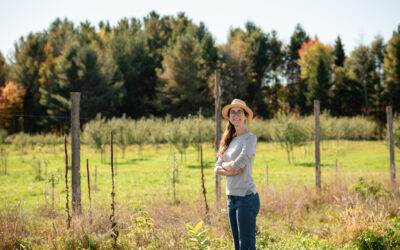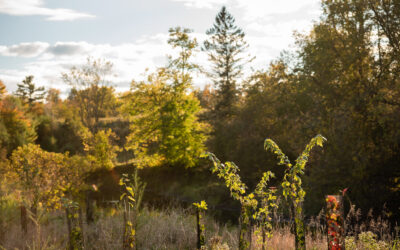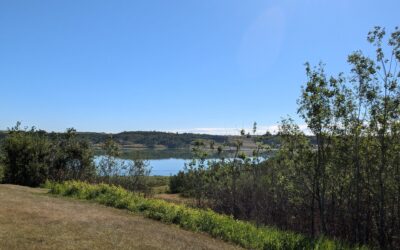Wetland projects are valuable nature-based solutions for farmers and ranchers looking for ways to mitigate environmental challenges on their land and in their community.
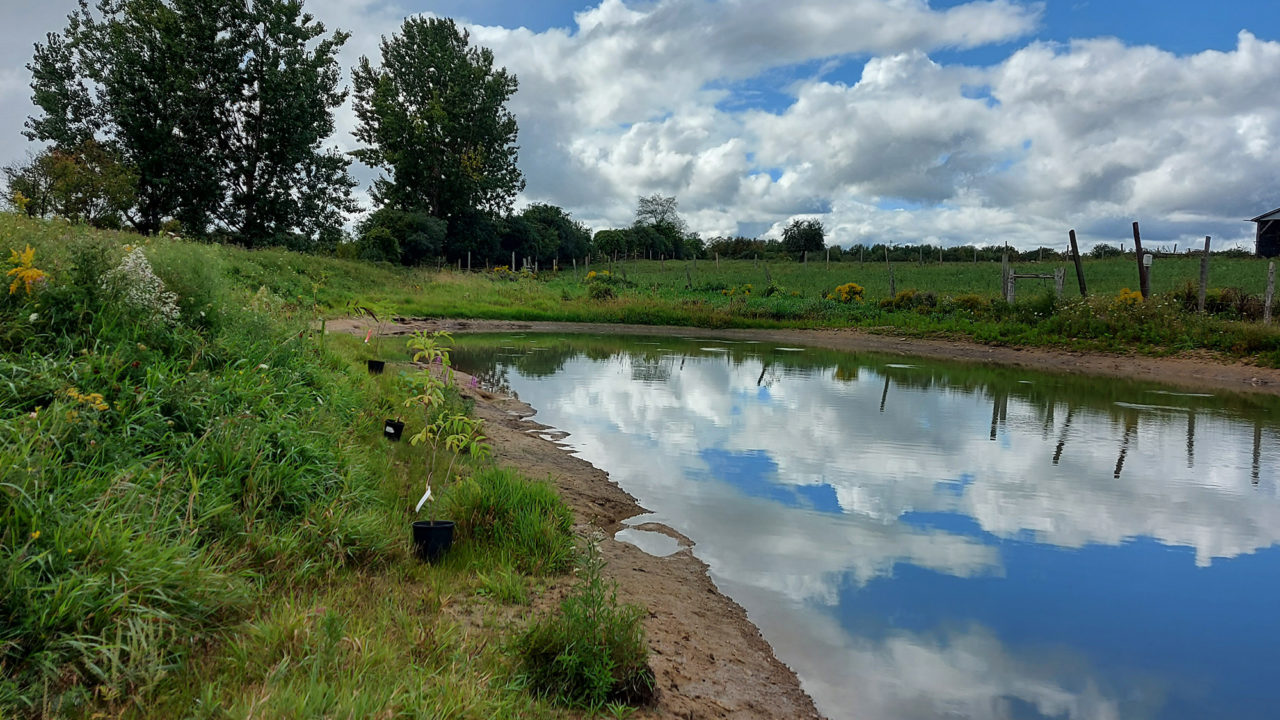
What is a wetland?
Wetlands are areas of land that are seasonally or permanently covered by shallow water or areas where the water table is close enough to the soil surface that wetland plants grow there. Canada has five main types of wetlands: fresh and saltwater marshes, swamps, bogs, fens and shallow open water. Wetlands are home to over 600 species of plants and animals in Canada and are some of the most productive ecosystems on earth.
Why are wetlands important?
Wetlands provide food and shelter for wildlife, while also delivering several ecosystem services that support thriving economies and communities, such as the following:
- Reducing the impacts of flood and drought
- Filtering water to improve water quality
- Slowing and holding water to support groundwater recharge
- Sequestering carbon
- Managing nutrients
These ecosystems will become more important as different regions continue to experience severe drought and rain events due to climate change.
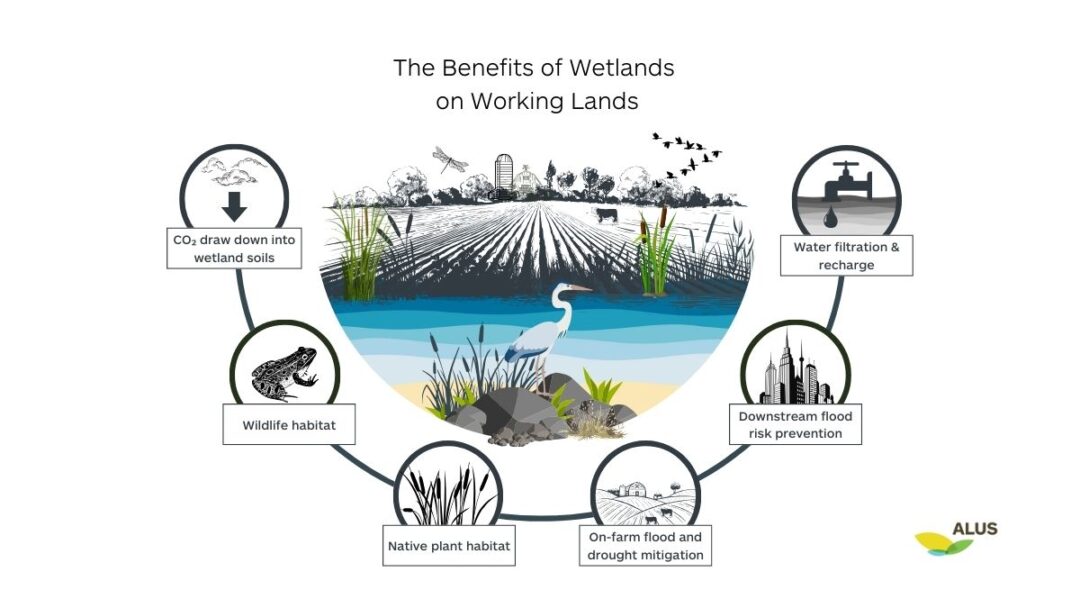
Wetlands in decline
Historically, wetlands were removed from farms to expand workable land. Drainage ditches were installed to remove standing water from fields. Approximately 70% of wetlands in southern Canada have been diverted, drained or filled over the last century due to land use changes, including urbanization. In urban areas, up to 98% of the wetlands have been removed.
The removal of wetlands has had negative consequences for water quality and quantity, has increased the risk of downstream flooding, and has contributed to biodiversity loss by removing critical aquatic habitat. Today, farmers and ranchers are realizing that wetlands can play an important role in building on-farm resilience, especially when faced with an increasingly unpredictable and changing climate.
Many existing wetlands remain under threat from continued land use conversion, as well as climate change and the spread of aggressive invasive species, like phragmites. Restoring and protecting wetlands is critical for maintaining Canada’s freshwater quality and quantity, reversing biodiversity loss, and mitigating the impacts of severe weather on farm operations and communities.
What you can do to enhance and restore wetlands
ALUS works with community partners across Canada to help farmers and ranchers create and restore wetlands on marginal agricultural lands. ALUS provides ongoing financial and technical support to ensure wetland and other nature-based projects continue to thrive and provide valuable ecosystem services.
Enhancing a wetland can often be done with simple land management changes, such as the following:
- Installing an alternative watering system that pumps water to a trough and keeps livestock out of sensitive wetland areas, and/or
- Creating a buffer between wetland areas and cropland.
Restoring a wetland often starts with removing drainage features and replanting the area with native wetland species.
Creating a wetland is done by excavating an area of the farm that naturally collects exposed groundwater or surface run-off.
Wetland maintenance requires ongoing monitoring for invasive species and bank erosion. Detecting invasive species early is the fastest and most cost-effective way to ensure wetland health. ALUS communities provide ongoing support and access to technical expertise to help with wetland management.
Explore the potential of wetlands on your land. Find your ALUS community.
Learn more about wetlands in Canada
- Water Sources: Wetlands (Government of Canada)
- The Contribution of Wetlands Towards a Sustainable Agriculture in Canada (CAPI)
Learn more about wetlands in the USA
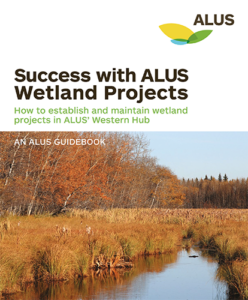
Wetlands Guidebook
ALUS has created informative guidebooks for its Eastern and Western communities
For the Love of Apples and Pollinators
Danielle Newman standing next to her windbreak at Alluvia Farm in Bristol, Quebec. Photo: Jan Amell PhotographyDanielle Newman and Philippe Smith are going back to their roots with Alluvia Farm, an organic farm in Philippe’s hometown of Bristol, Quebec. Alluvia...
ALUS to deliver nature-positive benefits to rural communities with continued financial support from TD Bank Group
The 2024-25 grant from TD marks the fifth year of funding the Bank has provided to ALUS and will support adding another 115 new acres of nature to the working landscape in Manitoba, Ontario and Québec. Toronto, ON, December 17, 2024 – Supported by TD, through its...
ALUS is accelerating carbon quantification capabilities with support of Cisco Foundation
December 9th, 2024, Toronto, Ontario --- Today, ALUS announced that it received grant support from Cisco Foundation, which will strengthen its carbon quantification capabilities. The grant will enable ALUS to develop and test three innovative technologies that use AI...

